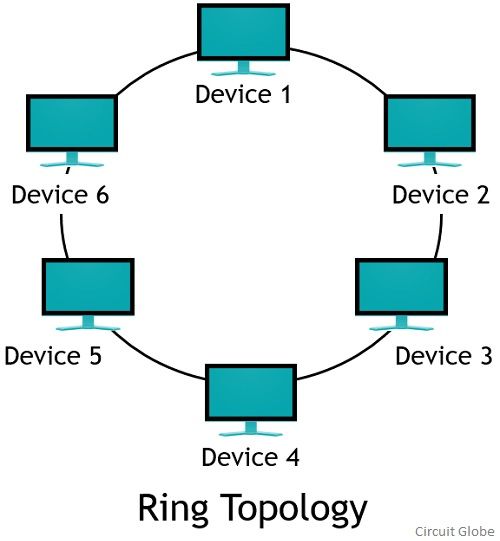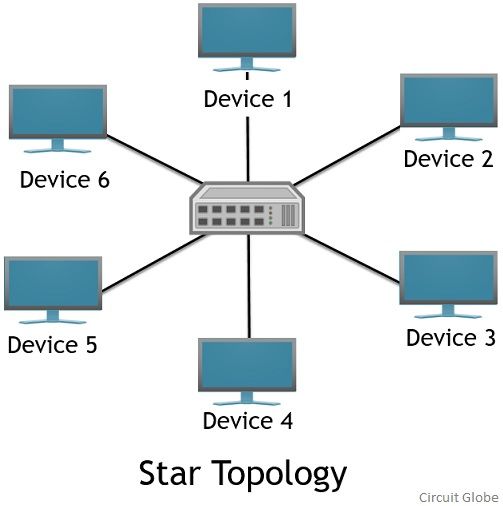One major difference between star and ring topology is that in star topology the devices in the network are interconnected through a central hub. While in ring topology each device of the network is connected to its adjacent device present in the network.
We know that topology refers to the way in which multiple devices in a network are connected in order to have transmission of data. So, in this article we will discuss what are the major factors that differentiates star topology from the ring topology.
Content: Star Vs Ring Topology
Comparison Chart
| Basis for Comparison | Star Topology | Ring Topology |
|---|---|---|
| Connection Type | Centralized connection or client-server model. | Peer to peer connection. |
| Central Host | Required | Not required |
| Troubleshooting | Easy | Comparatively difficult |
| Cost | High | Low in comparison to star topology |
| Network failure | Only due to centralized hub. | Can be because of every single device present in the network. |
| Speed of transmission | Fast | Comparatively slow |
| Network Enlargement | Easy | Quite difficult |
| Data Flow | Directly to/from the hub. | It follows sequential data flow i.e., from one direction to another. |
Definition of Star Topology
Star topology is a way of connecting multiple devices in a network by the help of a central hub. This means all the devices will be connected to each other through a central host unit. The transfer of the data between the devices will be accomplished through the central hub only.
The figure below represents the network using star connection:
As we can see in the figure shown above that each device of the network is individually connected to the hub through separate cabling. Due to this connection whenever, a fault appears in any of the devices of the network, then its detection and solution becomes quite easy. But in this case, when the fault appears at the central hub of the network then it breaks down the whole network completely, as all the devices are directly connected to this particular hub.
The devices in the network are connected via coaxial, fiber or twisted pair cables with the centralized hub.
Definition of Ring Topology
Here the name itself is suggesting that in ring topology the devices in the network forms ring type connection in a way that each device is directly connected to the devices present next to it. So, in this case at the time of data transmission the information flows in a sequential manner, it can be either in clockwise direction or anticlockwise direction.
This is so because in direct connection of the devices with each other, each device sends or receive data from the device present adjacent to it.
The figure here shows network orientation in the form of ring:
 Here it is clear from the figure shown above that device 1 is directly connected to device 2 and 6 with separate cables. This represents peer to peer connection between the devices in the network.
Here it is clear from the figure shown above that device 1 is directly connected to device 2 and 6 with separate cables. This represents peer to peer connection between the devices in the network.
It is to be noted here that repeaters are necessarily required to be installed in ring network. As when large number of devices are present in the network, then at that time, transferring the information by passing through each device between source and destination can lead to chances of data loss. Thus, in order to prevent the loss of data, repeaters must be installed in the network.
In ring topology as not only source and destination are involved in data transfer. But the other devices between them passes the information. So, due to this in case if a single device gets failed then it will lead to failure of the whole network.
Key Differences Between Star and Ring Topology
- As in star topology the devices in the network are connected to a centralized hub, thus a central host is required in this type of topology. However, in ring topology there exist no such need for a central host due to adjacent connection of the devices in the network.
- Star topology permits easy troubleshooting as faults can be easily detected and solved. While ring topology offers comparatively difficult fault analysis.
- Star topology holds client-server connection. Whereas ring topology is a peer-to-peer connection type.
- The networks formed by star topology are quite expensive as compared to that of ring topology.
- In star topology, the complete network will fail only when the central hub gets failed. As against in ring topology, if any of the device of the network gets failed than it will lead to failure of the complete network.
- The flow of data or information in star topology do not follow any specific manner as central host distributes the data to all the devices present in the network. Whereas, in ring topology the flow of data takes place in sequential manner either in clockwise or anticlockwise direction.
- The network expansion is somewhat easier in case of star topology than ring topology. This is so because the whole network will get disturbed whenever there exist a need for a new device in the network.
- The data transmission speed is faster in star topology than in ring topology.
Similarity
In both star and ring topology, the number of cables required to form connection within the network are equal. Suppose for total 6 devices in the network, 6 cables will be required in case of star and ring topology both.
Conclusion
So we can conclude that though star topology is expensive but is more advantageous than ring topology.

